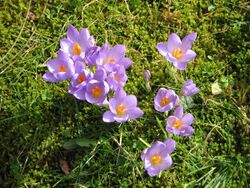Biology:Crocus etruscus
| Crocus etruscus | |
|---|---|

| |
| Scientific classification | |
| Kingdom: | Plantae |
| Clade: | Tracheophytes |
| Clade: | Angiosperms |
| Clade: | Monocots |
| Order: | Asparagales |
| Family: | Iridaceae |
| Genus: | Crocus |
| Species: | C. etruscus
|
| Binomial name | |
| Crocus etruscus Parl.
| |
Crocus etruscus (Tuscan crocus) is a species of flowering plant in the genus Crocus of the family Iridaceae, endemic to woodlands of Central Tuscany (Italy).[2] It is a cormous perennial growing to 8 cm (3.1 in) tall. The lilac flowers with purple veining and prominent orange stigmas appear in early spring.[3]
Description
Crocus etruscus is a herbaceous perennial geophyte growing from a corm. The corm is globe shaped with a flat top, the tunic is coarsely netted and a secondary star-shaped tunic is produced around the basal plate (where the roots are generated). Flowers are lavender-blue with gray-blue outer surfaces that are marked with dark veining. The three-branched, orange-red stigma is generally taller than the anthers. Flowering occurs in late winter- early spring.[4] Plants are self-incompatible,[5] meaning that viable seeds are not produced when pollination occurs among flowers of the same corm. The anthers open up away from the center of the flower to release pollen.[5]
Habitat
It is found growing in sub-Mediterranean deciduous woods and stony fields; the species may be in bloom from February to April.[6] The specie is almost extinct in the wild.[4] It has a restricted natural range, being endemic to the southwestern part of Tuscany.[5]
In nature the plant has "near-threatened" status.[1] However, it also appears in cultivation. It has gained the Royal Horticultural Society's Award of Garden Merit.[7]
Cultivars
- Crocus etruscus 'Zwanenburg' is a cultivar with flowers that are pale violet-gray. The flowers have lilac-blue and deep violet-blue striations, with pale yellow throats, and orange anthers.
- Crocus etruscus 'Rosaline' is a cultivar with soft pink flowers.[4]
References
- ↑ 1.0 1.1 Carta, A.; Peruzzi, L. (2011). "Crocus etruscus". IUCN Red List of Threatened Species 2011: e.T161939A5516365. doi:10.2305/IUCN.UK.2011-1.RLTS.T161939A5516365.en. https://www.iucnredlist.org/species/161939/5516365. Retrieved 13 November 2021.
- ↑ "Contributo alla conoscenza della flora vascolare endemica di Toscana ed aree contermini. 1. Crocus etruscus Parl. (Iridaceae)". Inform. Bot. Ital 42 (1): 47–52. 2010.
- ↑ RHS A-Z encyclopedia of garden plants. United Kingdom: Dorling Kindersley. 2008. pp. 1136. ISBN 978-1405332965.
- ↑ 4.0 4.1 4.2 Jelitto, Leo; Schacht, Wilhelm; Epp, Michael E.; Baumgardt, John Philip; Fessler, Alfred (1990). Hardy herbaceous perennials. Portland, OR: Timber Press. p. 170. ISBN 0-88192-159-9. OCLC 20012412.
- ↑ 5.0 5.1 5.2 "The avoidance of self-interference in the Tuscan endemic spring geophyte Crocus etruscus Parl. (Iridaceae)" (in en). Plant Biosystems 150 (6): 1358–1363. 2016-11-01. doi:10.1080/11263504.2015.1118164. ISSN 1126-3504.
- ↑ Phillips, Roger; Rix, Martyn (1989). The Random House Book of Bulbs. Random House. p. 25. ISBN 978-0-679-72756-9. https://books.google.com/books?id=o_7wAAAAMAAJ.
- ↑ "Crocus etruscus". Royal Horticultural Society. http://apps.rhs.org.uk/plantselector/plant?plantid=2561.[yes|permanent dead link|dead link}}]
Wikidata ☰ Q5187442 entry
 |


